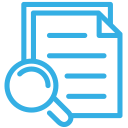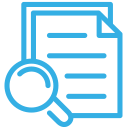What Was Changed
The new auditing standard retained the pass/fail opinion of the existing auditor's report, but made significant changes to the auditor's report, including:
- Communication of critical audit matters—matters communicated or required to be communicated to the audit committee and that: (1) relate to accounts or disclosures that are material to the financial statements; and (2) involved especially challenging, subjective, or complex auditor judgment.
- Disclosure of auditor tenure—the year in which the auditor began serving consecutively as the company's auditor.
- Other improvements to the auditor's report—a statement that the auditor is required to be independent, changes to certain standardized language in the auditor's report, and changes to the standardized form of the auditor's report.
Additional information on the new auditing standard:
- SEC Action: Release No. 34-81916
- Auditing Standard: AS 3101: The Auditor's Report on an Audit of Financial Statements When the Auditor Expresses an Unqualified Opinion
- Adopting Release: PCAOB Release No. 2017-001
- Fact Sheet: Adoption of an Auditing Standard on the Auditor’s Report

Why Did the PCAOB Adopt This Standard?
The PCAOB adopted the standard to make the auditor's report more relevant to investors and other financial statement users by requiring more information about the auditor and the audit.
The communication of critical audit matters arising from the audit is intended to inform investors and other financial statement users about matters that required especially challenging, subjective, or complex auditor judgment, and the response that the auditor had to those matters.
Disclosure of auditor tenure in the auditor's report will make this information readily accessible in a timely way for investors who find it useful.
The other improvements to the auditor's report are intended to enhance the user's understanding of the auditor's role and responsibilities related to the audit of the financial statements, make the auditor's report easier to read, and provide a consistent format.

What Are the Effective Dates?
- Provisions related to the disclosure of audit tenure and other improvements to the auditor's report took effect for audits for fiscal years ending on or after December 15, 2017.
- Provisions related to critical audit matters will take effect for audits for fiscal years ending on or after June 30, 2019, for large accelerated filers; and for fiscal years ending on or after December 15, 2020, for all other companies to which the requirements apply.

How is the PCAOB Monitoring the New Standard's Implementation?
We strive to be proactive, accessible, transparent, and clear in our communications about the new standard and its implementation. We are proactively providing information and training directly to auditors. Our standard-setting professionals are also providing guidance and responding to specific questions via telephone or email. We are engaging with key stakeholders to better understand their experiences and any implementation questions that may need to be addressed.
The PCAOB is observing what audit firms are doing to implement the new requirements, placing particular emphasis on how they are preparing to identify and communicate CAMs. The staff is working to prevent and detect problems during implementation by:
- Monitoring audit firms through communications with them.
- Promoting compliance through inspections of audit firms.
In this June 2019 video, Megan Zietsman, then the PCAOB’s Chief Auditor, described PCAOB resources on CAMs ahead of the standard’s effective dates.

Staff Guidance
The PCAOB staff provides guidance to help firms when implementing CAM requirements. Staff may update this guidance as needed.
Implementation of Critical Audit Matters: A Deeper Dive on the Communication of CAMs (May 22, 2019)
Implementation of Critical Audit Matters: The Basics (March 18, 2019)
- Staff Guidance – Changes to the Auditor's Report Effective for Audits of Fiscal Years Ending on or After Dec. 15, 2017 (updated Aug. 23, 2018)
- Annotated Example Auditor’s Report for the Audit of a Broker or Dealer (Dec. 18, 2018)

Webinars
Our standard-setting professionals also provide information through educational webinars.
The New Auditor's Report and Critical Audit Matters
In May 2019, the PCAOB staff hosted this webinar on implementation of the new CAM requirements. The webinar covered CAM determination, communication, and documentation requirements, as well as other considerations relevant to the CAM requirements. Download the slides from the webinar.
Overview of Changes to the Auditor's Report

Additional Resources
Critical Audit Matters Spotlight
This Critical Audit Matters Spotlight focuses on observations from our inspections of these new requirements and from our outreach and data analysis activities.
Consistent with the Board’s strategic goal of providing more useful and timely information, we believe that sharing our initial observations from the experiences of the first adopters of CAM requirements could help auditors, companies, audit committees, and other stakeholders.
The information in this CAMs Spotlight is not staff guidance; rather, it highlights timely and relevant observations for auditors and other key stakeholders.
Assessing Initial Implementation of CAMs
The PCAOB released interim analysis reports and accompanying white papers in 2020 and 2022 examining the initial impact of the CAM requirements. To inform the analysis, the staff conducted extensive stakeholder outreach and large-sample statistical analysis. The staff’s stakeholder outreach included surveys of auditors and investors and interviews of audit committee chairs and preparers.
Further information on the interim analyses is available on our CAMs post-implementation page.
Evaluating Overall Impact
The PCAOB will continue to monitor the implementation of CAM requirements and evaluate the timeline for developing a more comprehensive post-implementation review. Because some of the effects of the CAM requirements may take several years to fully manifest or stabilize, the next analysis will be published no earlier than 2024. The future analysis will further evaluate the benefits and costs of the new standard, including any unintended consequences, to understand the overall impact on investors and other users of financial statements, auditors, and public companies.


